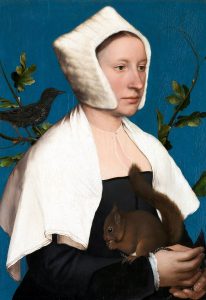Lady with a squirrel
At that time, were common pets among the English upper class. If you look closely, you’ll notice the little chain that stops the squirrel from escaping and that Lovell holds in her right hand. Also, it is thought that the squirrel is a reference of the Lovell family name, as this little animal is in their coat of arms. But more interesting that the squirrel anecdote is the fact that Holbein, formally, belongs to what is called the northern renaissance movement. But of course, renaissance per se wasn’t that influential in German countries as the gothic art, style that survived since the 12th century.
It would seem like Lady with a squirrel and a starling to be a spectacular synthesis between the renaissance and the gothic. Many compare this paintings to Leonardo’s portraits, however, the clothes and the cold, livid and strict look the of woman remind us the gothic paintings; and the squirrel, joyful and playful
Lady with a squirrel and a starling – Hans Holbein the younger 1528
The direct approach, also called alla prima, is about painting the right color directly onto the canvas or painting surface immediately, working while the paint is still wet, also called wet-on-wet. This is a much faster and immediate way of painting, with the painting often finished in one sitting or session. When painting directly, the artist wants to find the right hue, value, and saturation of the color before laying it down on the canvas in order to get the color and shape down correctly the first time
Lady with a squirrel and a starling – Hans Holbein the younger 1528
